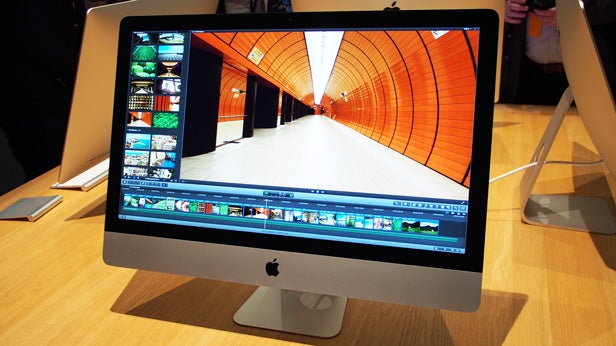
Verdict
Apple’s event on the 16th October wasn’t just about the iPad Air 2 and iPad mini 3.
The big surprise of the night was the impressive new iMac all-in-one
with a Retina 5K screen. It’s the most high-resolution display that’s
ever been made commercially available – and it fits into the same sleek
aluminium body as the iMac 2013.
The
internals have also had an upgrade. The basic model comes with a 3.5GHz
core i5, 8GB RAM, a 1TB Fusion Drive and an AMD Radeon R9 M290X with
2GB of video RAM. That’ll set you back a cool £2000/$2499, but if you
opt for the top-spec combo of 4GHz core i7, 32GB RAM, 1TB SSD and AMD
Radeon R9 M295X with 4GB GDDR5, you need to shell out £3519/$4399. Any
version you get will, of course, come with OS X Yosemite preinstalled.
It’s
the fastest iMac we’ve ever seen, and to power that incredible screen,
it needs to be. And it’s the display that is the star of the show here.
The
iMac with Retina 5K Display comes with a resolution of 5120 x 2880,
doubling the number of pixels along the axes of the 2560 x 1440 older
model. To put that in a bit of context, the iMac 5K has 14.7 million
pixels – that’s seven times the resolution of the 1080p full HD TV
you’ve got at home. All in a 27-inch display.
What this high-res
screen means in practice is that you’ll be able to edit a 4K video in
real size with all the controls of whichever app you’re using – such as
Final Cut – surrounding it. Apple market this as a consumer desktop, but
the reality is that it’s more of a prosumer computer – you’ll probably
need to have a good reason to shell out that much on a computer just to
check your emails and create presentations.
Apple claims that
the contrast ratios are better than ever, too, and we can’t refute that
based on our time with the 5K iMac. Dark scenes look detailed and showed
zero banding. The lack of colour bleeding or banding is down to what
Apple calls organic passivation – a technology we first saw on the iPad
3.
Organic passivation separates the signals to light up from
the pixels. This eliminates cross talk and stops pixels leaking colour
into each other. And it works. Colours looked superb – bright and vivid,
but realistic. It’s also a lot more energy efficient. Apple claims that
the screen on the iMac Retina 5K is 30% more energy efficient than its
non-5K counterpart.
Some of that added efficiency comes from the
new oxide-based TFT layer. This sends the charge to each pixel,
charging them and keeping them charged. According to Apple this was
essential to enable the new iMac to deliver consistent and uniform
brightness across the whole 14.7 million-pixel display.
Apple
has had to manufacture a bespoke TCON for the iMac 5K. The TCON, or
timing controller, tells every pixel what it needs to be doing – it’s
the brains of the operation. With four times the pixels of the previous
iMac, the TCON on the 5K display needed to be four times as powerful.
It’s
remarkable that Apple has managed to get a screen that can show this
much detail into a body that’s only 5mm thick at its edge. In fact the
display panel on its own is just 1.4mm thick.
iMac with Retina 5K Display | Early Verdict
The
iMac is still a winner in terms of design, but there’s only one real
talking point with this desktop, and that’s the 5K screen. It’s hugely
impressive, even at first glance, and will make graphic designers, video
editors and camera buffs froth at the mouth with anticipation.
With
a starting price of £2000/$2499 this is not a computer for the masses.
But when you consider that the price of a good 27-inch 4K screen is
upwards of £1000/$1500, the iMac Retina 5K doesn’t seem unreasonable.
Next read: Best Monitors
